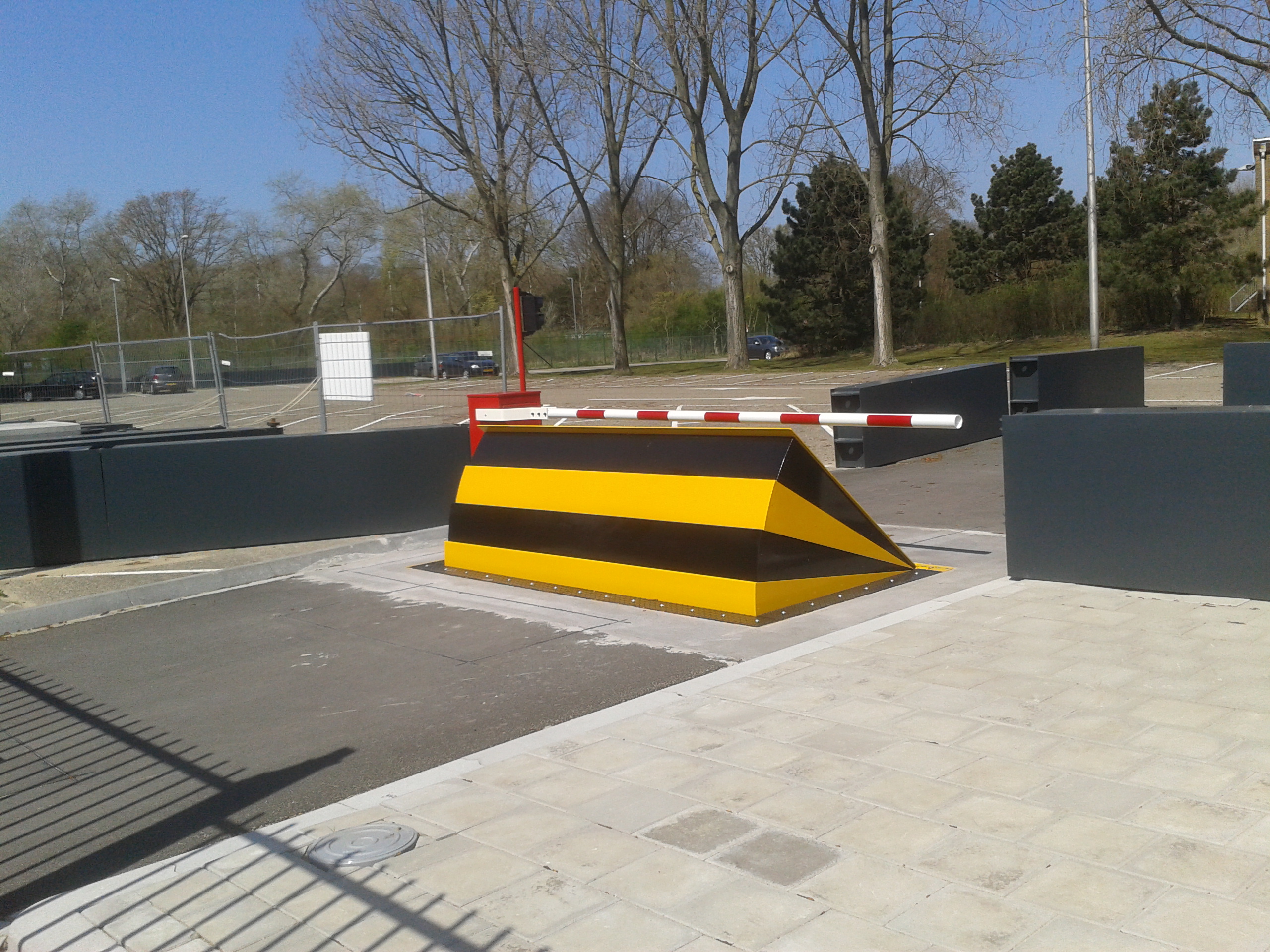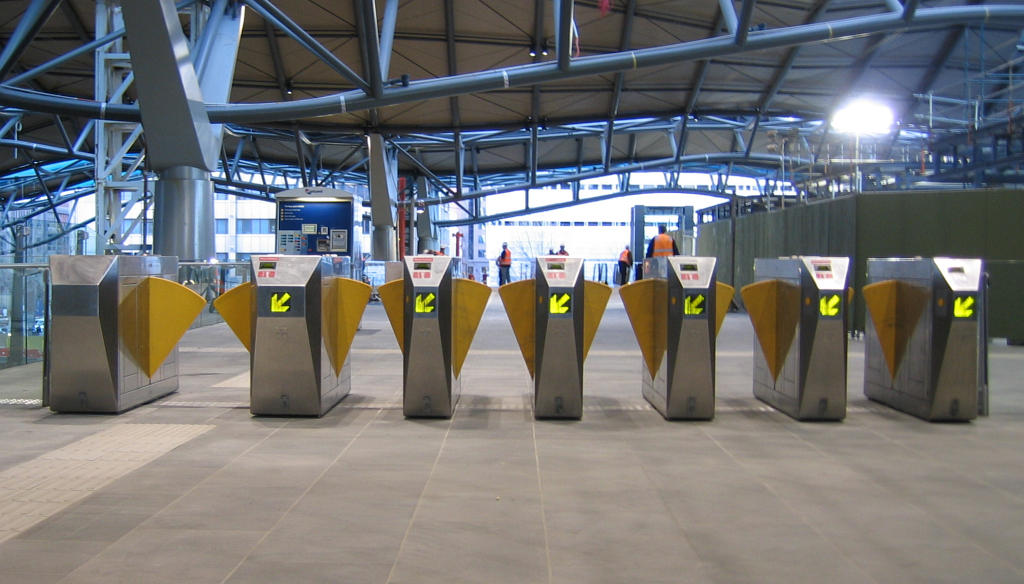Difference between revisions of "Barrier"
Jump to navigation
Jump to search
| (23 intermediate revisions by the same user not shown) | |||
| Line 1: | Line 1: | ||
A '''barrier''' is a (or barricade) is a physical [[measure]] with the aim to block or impede traffic flows. |
A '''barrier''' is a (or barricade) is a physical [[measure]] with the aim to block or impede traffic flows.[[Image:Security barrier at Wellington Monument - geograph.org.uk - 1491330.jpg|thumb|right|300px|Barriers can be shaped into artistic objects (Wellington monument, UK)]] |
||
== Description == |
== Description == |
||
A barrier as measure is an intentional obstruction of traffic, irrespective of its [[modes of transport|mode]]. A barrier |
A barrier as measure is an intentional obstruction of traffic, irrespective of its [[modes of transport|mode]]. A barrier can either by static (in place all the time) or dynamic (able to actively open or close). |
||
Barriers can be labeled hard or soft, depending on the amount of effort it would take to overcome the barrier. This amount of effort can be mode specific; a gravel moat would be very hard to cross by car, but is relatively easy to cross on foot. |
|||
| ⚫ | |||
| ⚫ | |||
| ⚫ | |||
=== Static barriers === |
|||
[[Image:Hydraulic vehicle blocker.jpg|thumb|right|300px|Hydraulic vehicle blocker]] |
|||
* [[Wikipedia:Fitch Barrier|Fitch Barrier]], a plastic barrel filled with sand or water, used on highways as an impact attenuator |
* [[Wikipedia:Fitch Barrier|Fitch Barrier]], a plastic barrel filled with sand or water, used on highways as an impact attenuator |
||
* [[Wikipedia:Traffic barrier|Vehicle barriers]] (crash barrier), used to keep vehicles within their roadway such as the [[Wikipedia:Concrete step barrier|Concrete step barrier]], [[Wikipedia:Cable barrier|Cable barrier]], [[Wikipedia:Constant slope barrier|Constant slope barrier]], [[Wikipedia:F-Shape barrier|F-Shape barrier]] or [[Wikipedia:Jersey barrier|Jersey barrier]] |
|||
* [[Wikipedia:Roadblock|Roadblock]], a temporary installation to control or block traffic on a road |
|||
| ⚫ | |||
* [[Wikipedia:Traffic barrier|Vehicle barriers]] (crash barrier), used to keep vehicles within their roadway |
|||
* Gravel moat for vehicles |
|||
** [[Wikipedia:Cable barrier|Cable barrier]] |
|||
* Water obstacle |
|||
** [[Wikipedia:Concrete step barrier|Concrete step barrier]] |
|||
* [[Bollard]] |
|||
** [[Wikipedia:Constant slope barrier|Constant slope barrier]] |
|||
* Green separation (soft barrier) |
|||
* Traffic slowing measures, such as speed ramps (soft barrier) |
|||
| ⚫ | |||
** [[Wikipedia:Jersey barrier|Jersey barrier]] or K-rail, a type of concrete barrier used to divide highway traffic |
|||
* [[Wikipedia:Crowd control barrier|Crowd control barrier]], a type of temporary fencing |
* [[Wikipedia:Crowd control barrier|Crowd control barrier]], a type of temporary fencing |
||
* [[Wikipedia:Mojo Barrier|Mojo Barrier]], a type of temporary fencing used at festivals and concerts |
* [[Wikipedia:Mojo Barrier|Mojo Barrier]], a type of temporary fencing used at festivals and concerts |
||
=== Dynamic barriers === |
|||
[[Image:Metcard-barriers.jpg|thumb|right|300px|Dynamic people barriers]] |
|||
| ⚫ | |||
* Hydraulic vehicle blockers |
|||
* Electronic people barriers |
|||
{{references}} |
{{references}} |
||
Latest revision as of 09:45, 3 May 2013
A barrier is a (or barricade) is a physical measure with the aim to block or impede traffic flows.
Contents
Description
A barrier as measure is an intentional obstruction of traffic, irrespective of its mode. A barrier can either by static (in place all the time) or dynamic (able to actively open or close).
Barriers can be labeled hard or soft, depending on the amount of effort it would take to overcome the barrier. This amount of effort can be mode specific; a gravel moat would be very hard to cross by car, but is relatively easy to cross on foot.
Examples
Static barriers
- Fitch Barrier, a plastic barrel filled with sand or water, used on highways as an impact attenuator
- Vehicle barriers (crash barrier), used to keep vehicles within their roadway such as the Concrete step barrier, Cable barrier, Constant slope barrier, F-Shape barrier or Jersey barrier
- Guard rail
- Gravel moat for vehicles
- Water obstacle
- Bollard
- Green separation (soft barrier)
- Traffic slowing measures, such as speed ramps (soft barrier)
- Crowd control barrier, a type of temporary fencing
- Mojo Barrier, a type of temporary fencing used at festivals and concerts
Dynamic barriers
- Automatic full barriers, which serve to block roads at railway crossings
- Hydraulic vehicle blockers
- Electronic people barriers
Footnotes and references


